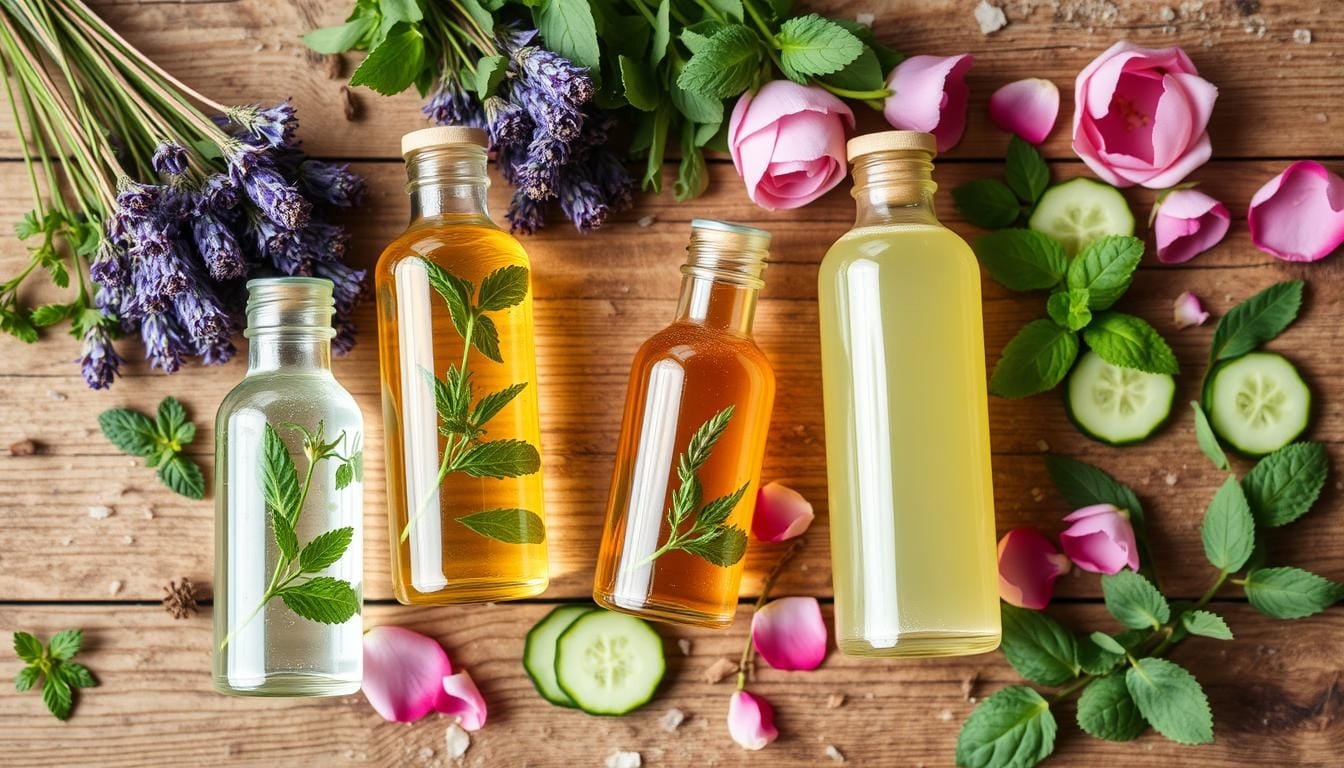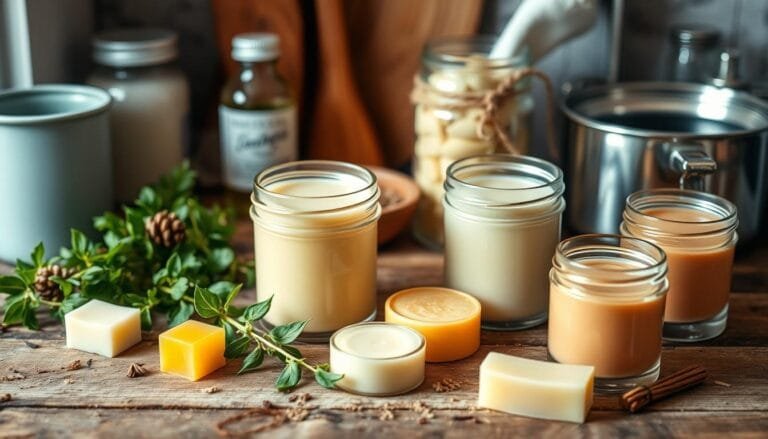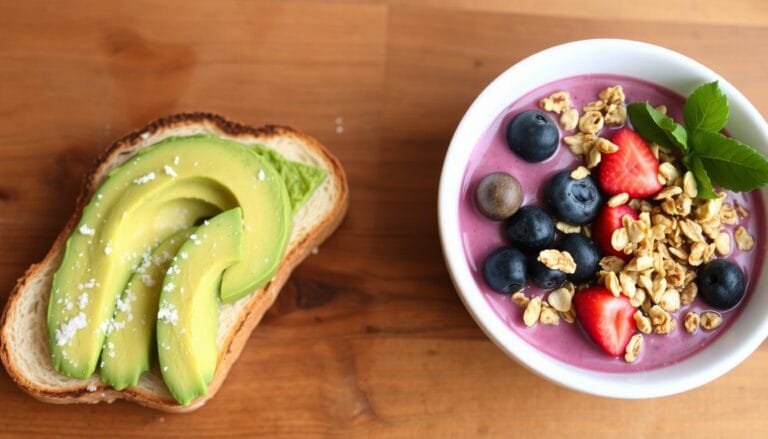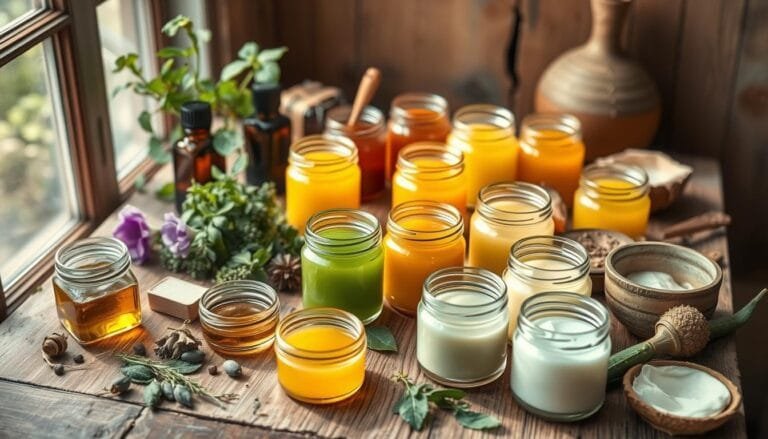I’ve found that homemade herbal face toners are amazing for your skin. They balance your skin’s pH, tighten pores, and remove dirt. In this guide, I’ll show you how to make your own toners for different skin types.
Many blogs talk about homemade skincare, like DIY toners. I’ve made a toner that works for dry, red, and irritated skin. It’s easy to make with just a few ingredients in minutes.
Using a toner in your skincare routine has many benefits. It hydrates, soothes, removes oil, refreshes, tightens pores, and balances pH. Knowing the right ingredients lets you make toners that fit your skin’s needs.
Understanding the Benefits of Natural Face Toners
Natural face toners are great for your skin’s health and look. They help balance your skin’s pH, add moisture, make pores smaller, and clean up after washing. These products are key to a good skincare routine.
Balancing Skin pH Levels
Keeping your skin’s pH right is key for a healthy glow. Toners fix your skin’s pH after washing, which can upset it. They help your skin stay healthy, making fine lines and wrinkles less noticeable.
Hydration and Pore Refinement
Ingredients like witch hazel and aloe vera in toners hydrate your skin. They make your skin feel soft and look smoother. These toners also make pores look smaller, giving you a more even skin tone.
Removal of Residual Impurities
Even after washing, your skin might have dirt and oil left. Toners remove these, getting your skin ready for other products. This makes sure your skincare routine works best.
Adding a natural face toner to your daily care can change your skin for the better. It balances pH, adds moisture, refines pores, and cleanses. This simple step can make your skin look radiant and healthy.
Essential Ingredients for Homemade Herbal Face Toners
When making homemade herbal face toners, some ingredients are key. We start with witch hazel and aloe vera. These two are natural wonders for the skin.
Witch hazel tightens pores and cleanses the skin. Aloe vera soothes and hydrates. We also use herbal infusions from dried flowers like lavender and chamomile. These add extra benefits.
We add vegetable glycerin for moisture. And essential oils for their benefits and scent. Oils like lavender and tea tree are great choices.
| Ingredient | Benefits |
|---|---|
| Witch Hazel | Astringent, reduces inflammation, tightens pores, cleanses skin |
| Aloe Vera | Soothing, hydrating, calms irritation |
| Herbal Infusions | Provide additional therapeutic properties based on the herbs used |
| Vegetable Glycerin | Helps retain moisture in the skin |
| Essential Oils | Offer various skincare benefits and aromatic properties |
By choosing and mixing these ingredients, you make a toner that’s just right for you. Get ready to see how natural skincare can change your skin!
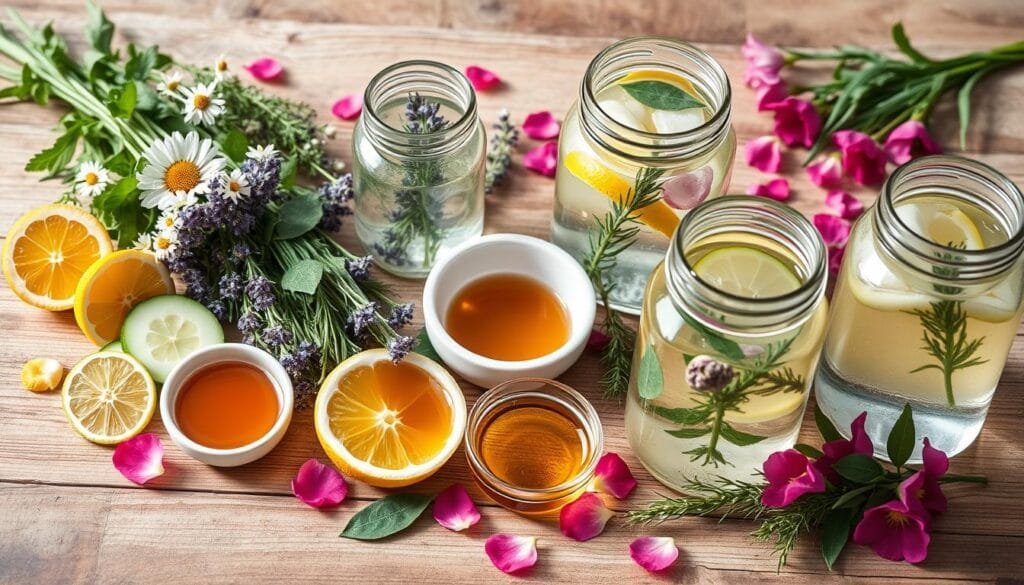
Base Ingredients: Witch Hazel and Aloe Vera Properties
Creating homemade toners is easier with two key ingredients: witch hazel and aloe vera. These natural wonders can change your skincare routine for the better.
Witch Hazel as a Natural Astringent
Witch hazel is a natural astringent that balances your skin’s pH, reduces redness, and shrinks pores. Its low pH is perfect for DIY toners. Choose alcohol-free witch hazel to keep your skin hydrated.
Aloe Vera’s Soothing Benefits
Aloe vera gel adds a cool and soothing touch to your toners. It boosts hydration and keeps moisture in, fitting all skin types. Mixing witch hazel with aloe vera makes a strong yet gentle soothing skincare solution.
“Witch hazel can be drying by itself, so diluting it with distilled water is recommended.”
When making your DIY toner, pay attention to the ingredient ratios. Finding the right mix is essential for the best skin benefits.
Herbal Infusions and Their Skin Benefits
Creating homemade herbal face toners is all about infusions. We use special herbs to make our DIY toners better for our skin. Let’s look at some great herbal infusions and how they can improve your skin.
Calendula is great for sensitive skin because it’s soothing and anti-inflammatory. Mixing witch hazel or aloe vera with calendula petals can calm redness and irritation. Your skin will feel refreshed and balanced.
Lavender is calming and helps reduce redness and even out your skin tone. It’s also good for controlling oil, making it perfect for oily or combination skin.
Rose hips are full of vitamin C, which makes your skin glow. They also protect your skin from harm and keep it healthy.
Chamomile is soothing and anti-inflammatory, perfect for calming irritated skin. Adding chamomile to your toner can make your skin feel calm and refreshed.
Try mixing different herbs to make a toner that’s just right for you. The secret to using these natural ingredients is in the infusion process.

| Herb | Skin Benefits |
|---|---|
| Calendula | Soothing, anti-inflammatory |
| Lavender | Calming, astringent |
| Rose Hips | Radiance-boosting, antioxidant |
| Chamomile | Soothing, anti-inflammatory |
Using herbal infusions, you can make a toner that meets your skin’s needs. It can help you get a healthy, glowing complexion. Always test a small area of your skin before using new herbal ingredients to make sure they work well for you.
Natural Additives: Glycerin and Essential Oils
Starting your journey to make a homemade herbal face toner is exciting. You’ll learn about vegetable glycerin and essential oils. These natural ingredients make your toner better and more soothing for your skin.
The Role of Vegetable Glycerin
Vegetable glycerin pulls in and keeps moisture in your skin. It’s a key part of your toner, keeping your skin hydrated and soft. Adding glycerin makes your toner thicker and more luxurious, feeling great on your skin.
Safe Essential Oil Usage
Essential oils add great benefits to your toner, but use them carefully. Hydrosols (floral waters) are safer for water-based products. Good essential oils for skin include lavender, tea tree, and frankincense. Always test a small area of your skin before using new ingredients.
Recommended Oil Combinations
- Lavender: Known for its calming and soothing properties, lavender essential oil can help to reduce redness and inflammation.
- Tea Tree: With its natural antiseptic and antibacterial qualities, tea tree oil can be beneficial for those with acne-prone skin.
- Frankincense: This versatile oil is prized for its ability to tone and tighten the skin, while also promoting a more even complexion.
When adding essential oils to your toner, use them sparingly. Always test a small area first to make sure your skin likes the blend.
“Utilizing the right combination of natural ingredients can transform a simple toner into a powerhouse of skin-nourishing benefits.”
Homemade Herbal Face Toners for Different Skin Types
Creating homemade herbal face toners means choosing the right ingredients for your skin. Whether you have oily, dry, sensitive, or combination skin, there’s a DIY toner recipe for you.
For oily skin, witch hazel and tea tree oil are great. Witch hazel balances oil and tightens pores. Tea tree oil fights breakouts and whiteheads. The St.Botanica Australian Tea Tree Anti Acne Face Toner combines these benefits.
Dry skin needs moisture and nourishment. Aloe vera gel and rose water are perfect. They moisturize and strengthen the skin. The Aloe Vera, Green Tea & Cucumber Face Toner from St.Botanica is ideal for dry skin.
For sensitive skin, use gentle ingredients like chamomile and calendula. They calm redness and inflammation. The Bulgarian Rose Otto Glow Deep Hydration Facial Toner from St.Botanica is great for sensitive skin.
For combination skin, find a balance. Witch hazel and aloe vera control oil and nourish. Green tea is also excellent, as it’s rich in antioxidants.
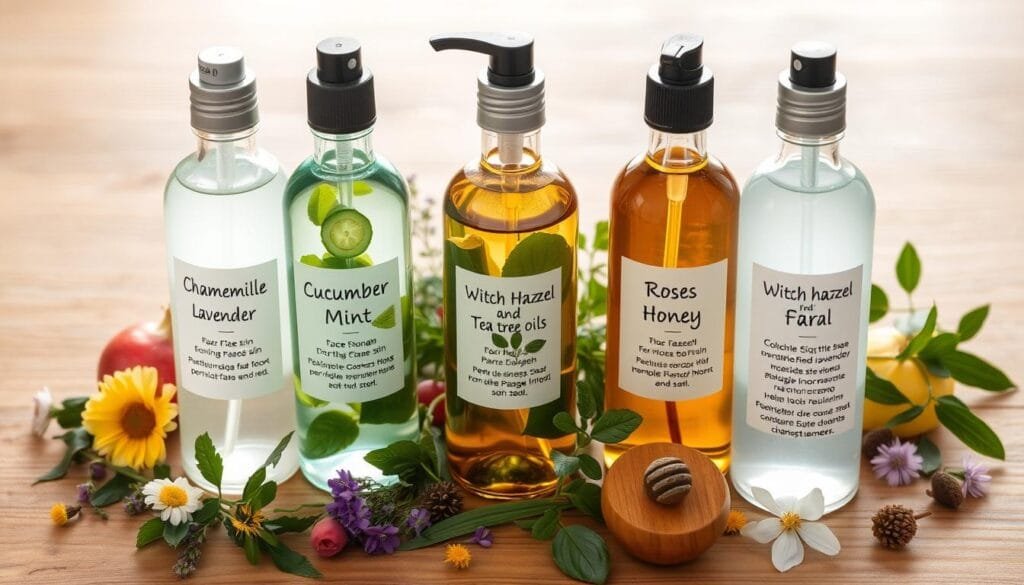
Homemade herbal face toners are natural and tailored to your skin. By choosing the right ingredients, you can make a toner that makes your skin glow and feel refreshed.
Step-by-Step Preparation Guide
Making your own natural face toner is easy and fun. You’ll need a few simple things from your home or a health food store. Let’s go through how to make your own herbal face toner step by step.
Equipment Needed
- A clean glass bottle or spray bottle (2-4 oz capacity)
- A small funnel (optional, for easy pouring)
- Measuring spoons or cups
- A clean, sterile mixing container
First, clean and sterilize your tools. This makes sure your toner is clean and lasts longer.
Mixing and Storage Instructions
In a clean glass container, mix the following:
- 1/3 cup Witch Hazel – a natural astringent that helps balance skin pH levels
- 1/3 cup Filtered Water – to dilute the witch hazel and create the toner base
- 15 Drops Tea Tree Essential Oil – known for its blemish-reducing properties
- 10 Drops Lavender Essential Oil – adds a soothing fragrance and can help reduce stress
After mixing, pour the toner into your bottle using a funnel. Don’t forget to label it with what’s inside and when you made it.
Keep your toner in a cool, dark spot or fridge. Homemade toners last 2-3 weeks in the fridge without preservatives.
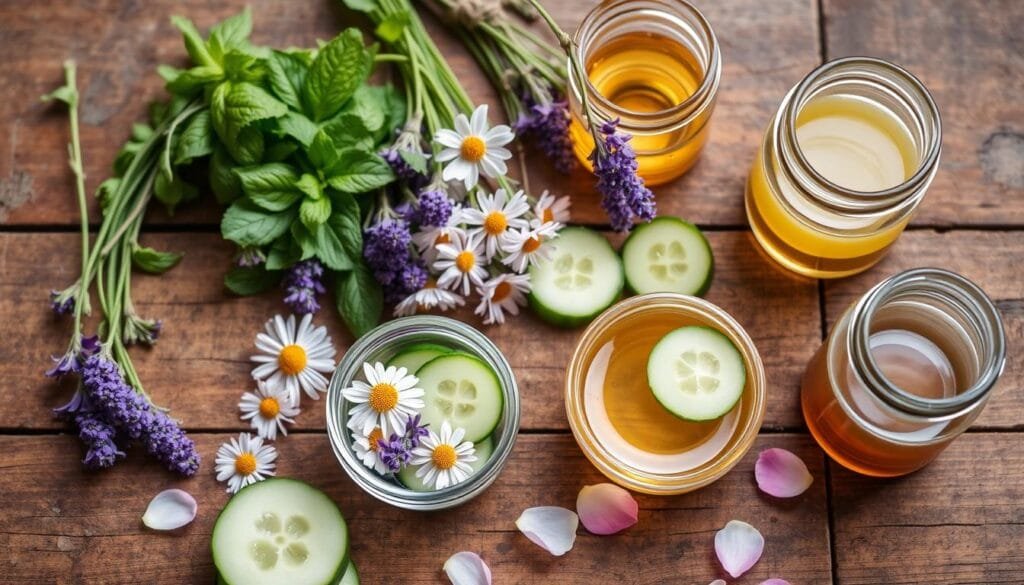
Creating your own face toner lets you tailor it to your skin. Try different herbs and essential oils to find the best for you.
Natural Preservatives and Shelf Life
When making your own natural skincare preservation products, adding preservatives is key. They help extend shelf life and stop bacteria growth. Ingredients like vitamin E and rosemary extract offer antioxidant benefits but aren’t true preservatives.
To keep your DIY toner shelf life long, use natural preservatives. Verstatil® TBG MB, Euxyl® K903, or Leucidal® SF MAX are good options. They have specific pH ranges and usage levels to protect your formulas.
For example, Verstatil® TBG MB works best in a pH of 4.0-6.0 at 1.0-1.5%. Euxyl® K903 prefers a 3-6 pH range and only needs 0.4-1.2%. Leucidal® SF MAX works in a 3.0-8.0 pH range and requires 2.0-4.0%.
Storing your refrigerated skincare properly is also important. Keeping it in the fridge slows down microbial growth. Just remember to use sterilized equipment and distilled water when mixing. Watch for any color, scent, or texture changes, as they might mean it’s time to throw it away.
| Preservative | pH Stability | Recommended Usage | Other Notes |
|---|---|---|---|
| Verstatil® TBG MB | 4.0-6.0 | 1.0-1.5% | Effective against Gram-positive and Gram-negative bacteria, yeast; requires solubilizer |
| Euxyl® K903 | 3-6 | 0.4-1.2% | Lipophilic components, effective at low concentrations for rinse-off and leave-on |
| Leucidal® SF MAX | 3.0-8.0 | 2.0-4.0% | Probiotic-based, broad-spectrum antimicrobial, more effective with a booster |
Understanding natural preservatives and proper storage helps keep your homemade skincare products fresh and effective longer.
Application Techniques and Best Practices
Adding a homemade herbal face toner to your skincare routine can really improve your skin. To use it right, let’s look at the best ways to apply it.
First, use your toner after you wash your face and before you moisturize. This helps remove dirt and gets your skin ready for other products. You can use a soft cotton pad or spray it on for a cool feel.
For a quick refresh, keep your toner in a spray bottle. Use it as a facial mist during the day. It’s great for keeping your skin hydrated, but don’t spray it near your eyes.
Remember, you can use toners in the morning and at night. But watch how your skin reacts. Start with using it once or twice a day and see how it goes.
| Toner Application Tips | Frequency Recommendations |
|---|---|
|
|
By using these tips, you can easily add your homemade herbal face toner to your skincare routine. You’ll see its many benefits.
“Toners are an underrated step in skincare, but they can make a big difference in the overall health and appearance of your skin.”
Alternative Natural Toner Recipes
Creating your own homemade herbal face toners opens up a world of possibilities! You can find toners for all skin types and concerns. From rose water for soothing to green tea for antioxidants, and chamomile for calming, these toners help you achieve glowing, balanced skin naturally.
Rose Water Toner
Rose water is gentle and helps balance your skin’s pH. Mix equal parts rose water and alcohol-free witch hazel. The witch hazel is a natural astringent, while rose water hydrates and soothes. This toner is great for all skin types, including sensitive or red skin.
Green Tea Infusion
Green tea is packed with antioxidants that fight free radicals. It makes your skin healthy and radiant. Brew strong green tea, cool it, and mix it with aloe vera gel. Aloe vera adds extra hydration and soothing to your skin.
Chamomile Blend
For a toner that calms irritation and soothes, try a chamomile blend. Steep strong chamomile tea, cool it, and mix it with honey and apple cider vinegar. Chamomile’s anti-inflammatory properties and apple cider vinegar’s gentle cleansing make it ideal for sensitive or inflamed skin.
Try these natural toner recipes to find the best one for your skin. The secret to a great homemade toner is using quality, gentle ingredients. They work together to restore your skin’s natural balance.
Tips for Maximizing Toner Effectiveness
Adding a natural face toner to my skincare routine has been a big change. To get the most from my homemade toners, I’ve discovered a few important tips. First, I always apply my toner to damp skin. This makes the active ingredients soak in better.
I use gentle, upward strokes with a cotton pad. This boosts circulation and helps with lymphatic drainage.
For oily areas, I let the toner sit for a few seconds before moisturizing. This lets it control shine and shrink pores. I also adjust my toner ingredients with the seasons. For example, I use a hydrating toner in winter and a mattifying one in summer.
After using any toner, I always moisturize to keep hydration locked in. Using toners in both my morning and evening routines has shown me their full skincare tips and toner benefits. With some trial and error, my customized toners have made my skin look and feel amazing.
